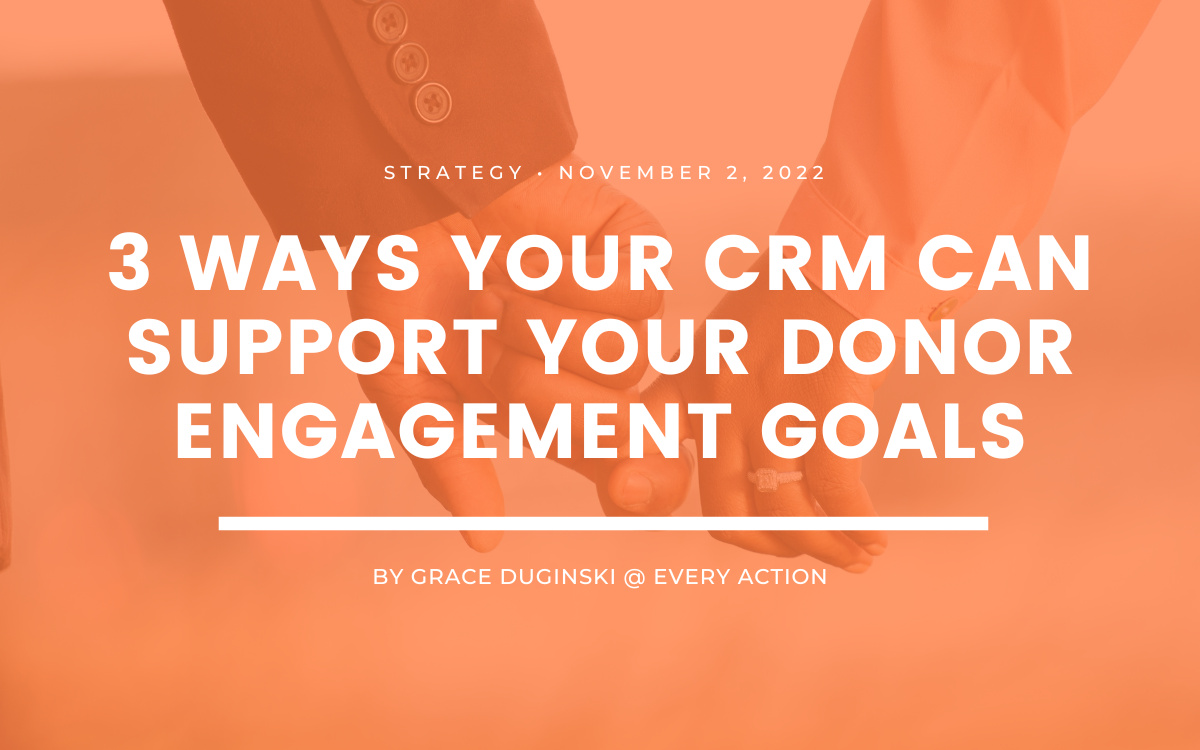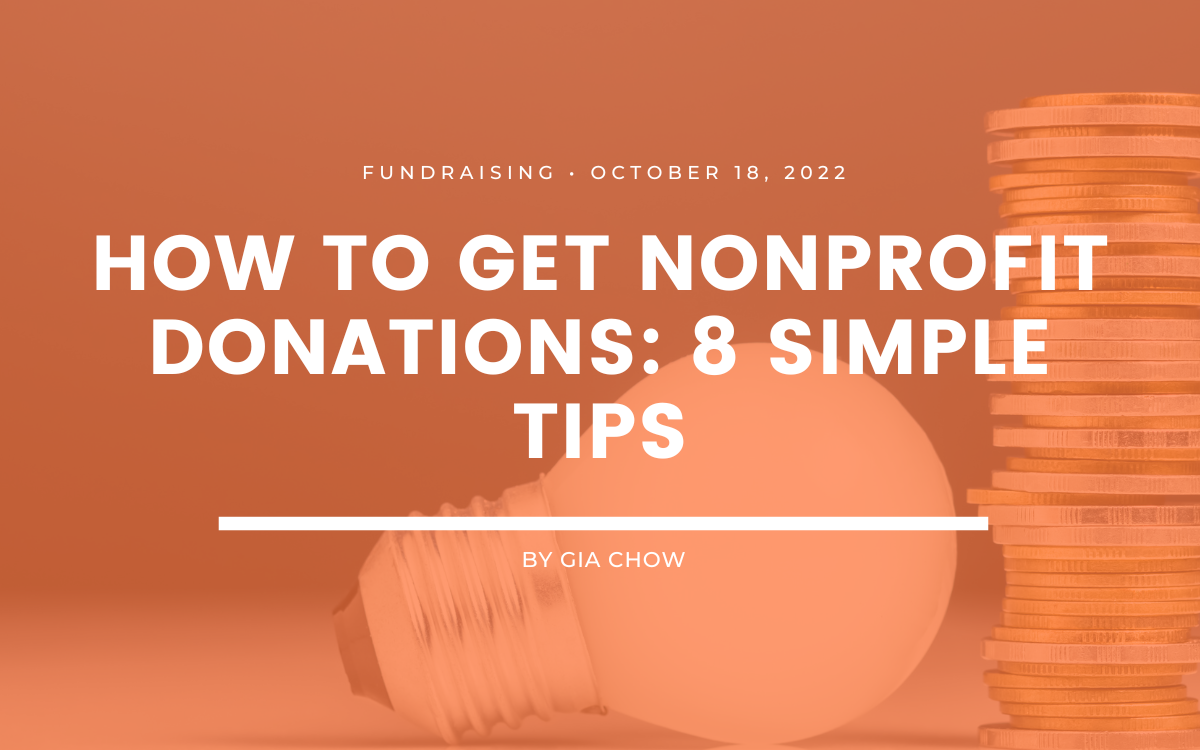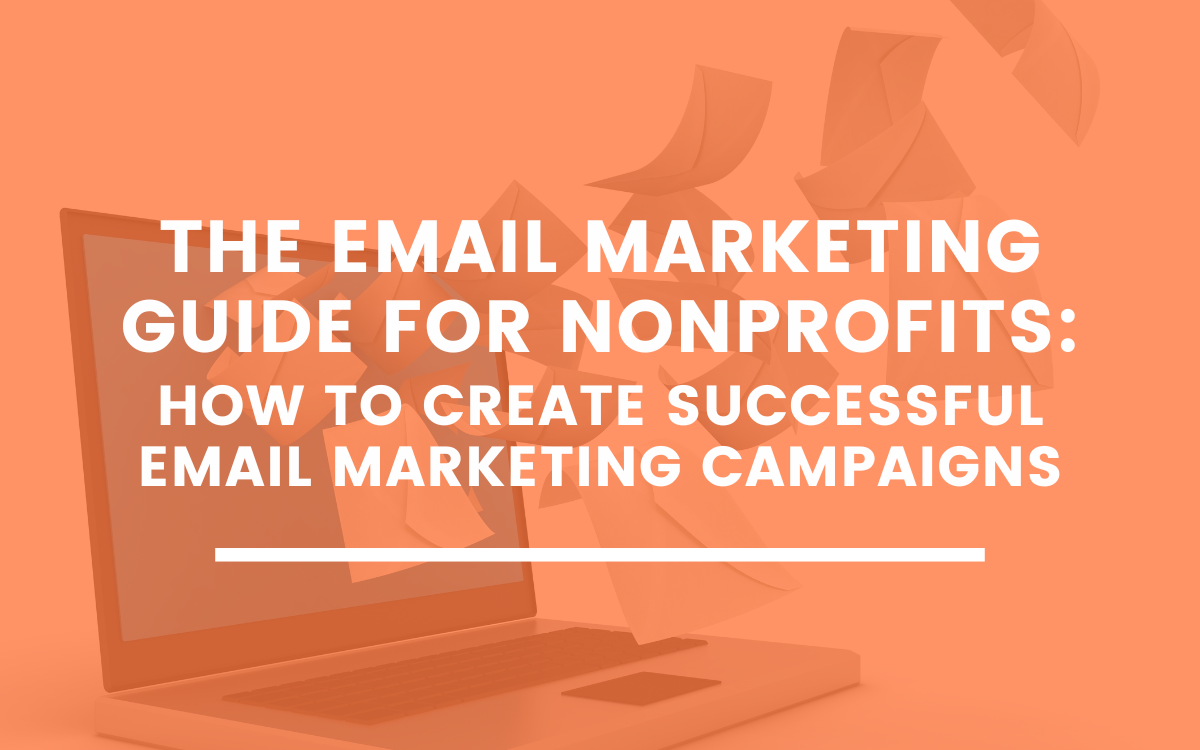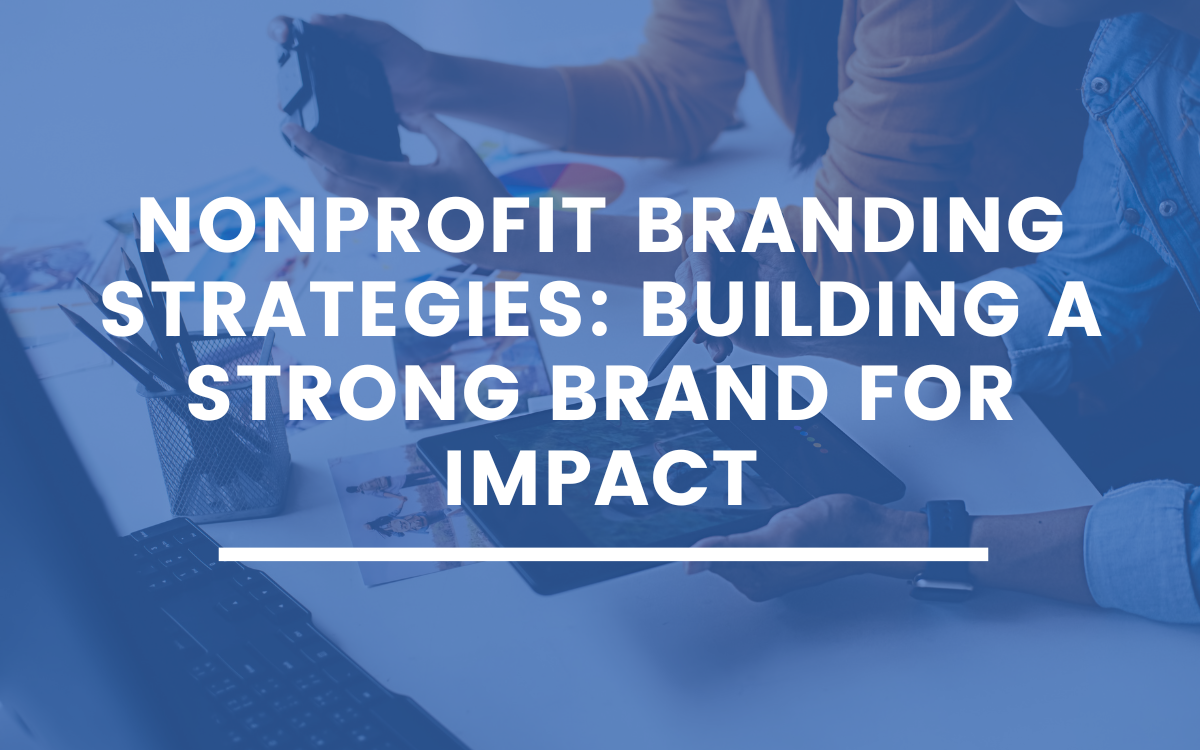3 Ways Your CRM Can Support Your Donor Engagement Goals
9 min to read ✭ When done right, donor engagement makes supporters feel valued and inspired to give again in the future—but sending every donor the right message at the right time can seem complicated. Here’s how your constituent relationship management (CRM) system can help!
When done right, donor engagement makes nonprofit supporters feel connected to your organization, valued, and inspired to give again in the future. As a fundraiser, your goal is to send them personalized messages in the channels where they’re most responsive right when they’re likeliest to be receptive to them, in order to demonstrate how much you value your relationship with them and share a vision of the impact you’re able to create with their support.
That’s the ideal scenario. However, sending all your donors all the right messages at all the right times can seem daunting, especially if you’re like most fundraisers and already have a long list of responsibilities. This is where your constituent relationship management (CRM) system can help: the right technology can give fundraisers the boost they need by taking on some of the tasks associated with donor engagement, so your nonprofit can work effectively and efficiently to fund your mission now and for years to come.
In this blog, we’ll share three ways your CRM or donor management software can help you reach your donor engagement goals more efficiently and effectively and ultimately raise more for your mission.
We’ll go over how your CRM can help you:
- Make the most of your channels to send the most effective donor engagement messages;
- Segment your donors to send them personalized and relevant engagement messages; and
- Raise funds strategically for your programs both when you’re planning for high traffic and when you aren’t.
Let’s go!
Donor engagement across channels
The future of fundraising is multi-channel—and your CRM can help you connect with donors using the right mix of channels to boost their odds of engaging with your messages.
Track where your donors are taking action
Your donors aren’t a monolith. Each supporter has preferences around how they take action, how they show support, and how they prefer to be contacted. It’s important to keep these preferences in mind when engaging with them to build your relationships: each message you send your donors should be informed by the latest steps your supporters took to support you, whether they clicked through an email, mailed in a check, or attended your event.
However, fundraisers are famously busy. Very few have time to check multiple siloed platforms for email results, texting results, volunteer shift results, and phone bank results—and then clean, cross-reference, export, and import all that data from platform to platform in order to make sure it’s correct and actionable. This is where your CRM can support you: when you track all these activities across channels in one centralized location, whether that’s a unified platform or a highly-integrated one, your whole team can get access to accurate, reliable donor data, meaning you can focus and personalize your donor engagement efforts to make them more effective.
It’s not a competition
Don’t think of a multi-channel strategy as a competition between email, direct mail, texting, digital ads, social media, and so on to see which one is “the best”—there’s really no one-channel-fits-all approach to fundraising. Your goal should be to test using different channels for different purposes across different donor segments and then using each channel to do what it’s best at doing.
For example, you might do some testing and realize your direct mail channel is particularly good for making the case and stewarding your donors with educational messages, while actually collecting a gift from one of those direct mail recipients works best for that audience using a channel like email or a digital form.
Ultimately, it’s all about knowing your audiences, and making sure that knowledge is stored in your CRM so all the right people at your organization can use it to help you raise even more for the mission.
How Your CRM Can Help
Your CRM can help you make the most of your different donor engagement channels without creating exponentially more work for busy nonprofit staff by making your donors’ information equally accessible to staff that need it and taking on some of the more mechanical tasks associated with cross-channel fundraising.
For example, when it comes to your email channel, are you sending out regular stewarding messages that don’t always involve a donation ask? Some CRMs support branched workflow automation, so you can set your donor outreach cadence based on specific triggers. When you can introduce this kind of efficiency into your donor engagement efforts, you can rest assured that your loyal supporters are hearing from you at the appropriate times without needing to manually press the send button on each and every message.
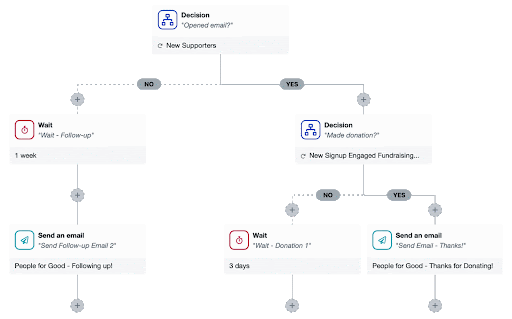
Another way your CRM can support your donor engagement goals across channels is in your donor acknowledgments. You can use the donor data in your CRM across channels to make sure you’re thanking your donors sincerely and quickly. That’s why a channel like mobile messaging can be a great way for some donors to receive your gratitude: it’s immediate and puts you on track to keep stewarding them toward their next gift. Some CRMs will even help you manage a mobile messaging program right in the platform, which means you can personalize those messages appropriately.
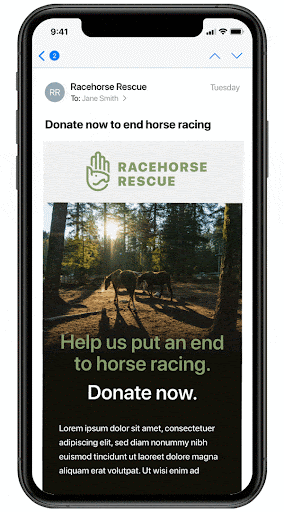
Donor segmenting and targeting
You wouldn’t message every donor the same exact way—and your CRM can help you use your data to customize the messages each supporter receives in order to get the best results.
What donor data should my nonprofit track?
It’s easy to get overwhelmed when it comes to donor data—there’s a nearly endless list of data points available for measuring, but there’s not much use collecting a lake of data if you can only act on about a puddle’s worth.
For most organizations, there are two types of donor data to focus on tracking in order to get a robust and helpful idea of who your supporters are: demographic data (or, who are our donors?) and behavioral data (or, what are our donors doing?) It’s important to collect and store that data in your CRM so you can use it to send your donors relevant messages both in the short term and in the long term. Sending donors relevant messages over time can help you build trust with them by demonstrating that you know them. Sending donor engagement messages that aren’t relevant, on the other hand, can make them feel that you aren’t paying attention to them, or even fatigue them to the point of unsubscribing.
By identifying your audiences around the way they’re most engaged with your organization—and recognizing and celebrating their different types of support—you can create supporter messages that put you on track for deeper engagement, make them feel seen and appreciated, and lead them to do whatever you are asking of them.
Try asking yourself these questions to identify helpful data points to collect:
Demographic data:
- Where does this donor live?
- How old are they?
- What’s their educational background?
- What other identities do they hold?
Behavioral data:
- How and where did you meet your donors?
- What messaging prompted them to engage with you?
- Is there a specific program, campaign, or initiative that they care about and want to support?
- How long have they been supporting you?
- What’s their average gift size, and what is the average gift size for other donors like them?
- What was the amount they gave as their last gift?
- Which emails and texts are they clicking through?
- Which donor segment/s do they currently fit into? How long do your donors typically stay in those segments before upgrading or changing?
How your CRM can help
Your CRM probably contains a treasure trove of donor data that you can use to test your donor engagement messages among your different segments and improve them based on what you learn from that testing.
For example, our friends at Network for Good and scholars at IUPUI’s Lilly Family School of Philanthropy found that Subscription GivingSM, a specific methodology for engaging sustainers, can help nonprofits retain them. Use the data in your CRM to test different donor engagement messaging to your recurring donors in line with those findings and see if they respond!
For your major donors and planned giving prospects, can you send those donors special cultivation messages across channels? The Agitator has reported on the notion that as Baby Boomers and Greatest Generation donors exit their prime giving years, they may be looking to make bequests to their favorite nonprofits. Using the data in your CRM to identify the likeliest prospects and educate them on planned giving can help you raise the funds you need to advance your mission and help them leave a legacy of generosity—it’s a win-win.
As you’re slicing and dicing your donor segments using the data in your CRM, your platform can also give you tactical support when it comes to actually sending those messages. If you’re testing different donor engagement messages to the same segment, some CRMs will even help you seize the moment and take action at the right time by automatically sending the winner of a multivariate test. It all boils down to letting your fundraisers devote their time to the tasks that really need a human touch, and letting your CRM technology carry out the tasks that don’t.
Donor engagement for strategic fundraising on high-traffic donation days
On top of your ongoing and evergreen fundraising campaigns, many (if not most) fundraisers want to make the most of big fundraising moments like GivingTuesday. These planned moments in the spotlight can help organizations reach high fundraising goals in a short period of time. But meeting them requires fundraisers to invest in donor engagement leading up to those 24 hours, during the event, and after it—and luckily, your CRM can take on some of this work.
[Vodcast episode: Preparing for Big Online Fundraising Days]
Preparing for the big day
Make sure donors are aware of your campaign, and give them plenty of opportunities to support you. Take what you’ve learned about channels and segments and put them into action together: as you prepare for a big day, make sure you’re using the data in your CRM to let your donors know in advance about ways they can support you that will appeal to them based on their history with you, and use channels to speak to them where the evidence says they’ll be responsive.
As you use the data in your CRM to contact donors before the big day, take the opportunity to add extra payment methods before the big day and let donors know about them. With payment methods like Apple Pay, PayPal, and Venmo growing in popularity, some organizations find they’re able to meet even more donors where they are by offering them. (Just ask Equality Florida: after adding PayPal to their giving methods, they now see at least half of all digital donations come in this way rather than via credit card.)
On the big day
The best way to ensure your CRM can help you engage your donors after the event is by making sure it’s set up to support you and collect accurate donor data on the day of the event itself. With the appropriate source codes, you can send donor engagement messages that are affiliated with your giving event. The right source codes will also help your team report on your successes, thank donors who gave, and steward them appropriately both online and offline. Busy fundraising teams can also set up automations to send off the right messages to the right donors at the right times, like sending quick updates throughout the day or whenever your campaign hits specific milestones.
For donors you’re engaging around online giving, your CRM and donation pages can help you use strategic interventions to make the most of a busy giving day. Tools like a sustainer upsell lightbox, one-click donations, a form to collect opt-ins for building your mobile messaging audience, or a friendly “handwritten” peer nudge to raise a higher average gift are all ways your technology can help you channel the energy of the moment into meeting long-term goals.
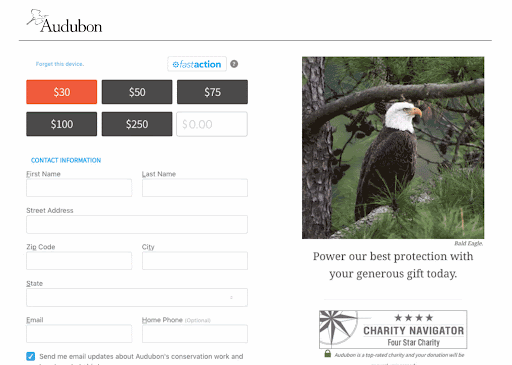
After the big day
Once your big fundraising day is over, the next immediate priority for many fundraisers is retaining the donors who participated. According to the Fundraising Effectiveness Project’s report for the year 2021, nonprofits saw a remarkable 26 percent increase in newly retained donors from the year 2020—a departure from the ongoing pattern of drops in donor retention we’ve seen since the Great Recession. The right donor engagement messaging and a boost from your technology can help you keep donors’ attention. Reference those source codes you set up prior to the event to thank your donors; identify any donors who may require personal attention from a major gifts officer and have your team track your progress stewarding them in your CRM; and personalize your messages across channels to reference their support for you on the big day.
Key takeaways
As you can see, the right constituent relationship management (CRM) system can give busy fundraisers an efficiency boost by taking on some of the tasks associated with donor engagement. Whether it’s identifying the right channels, testing messages across the right donor segments, or delivering messages to donors at just the right times, this kind of support means nonprofit staff can focus their time on the tasks that need creativity and a personal touch, not the mechanical tasks that don’t.
Ultimately, backing up your donor engagement efforts with technology can help you work effectively to fund your mission not just now, but for years to come—get a demo of EveryAction to learn more.


